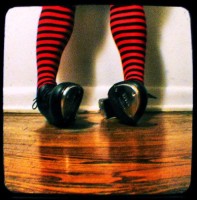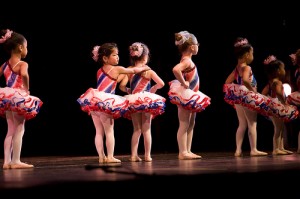 The first dance class I took was a tap class when I was 9 years old. I remember being so excited when I got my costume for the end of the year performance. I also remember my mom’s shocked reaction when she found out she had to spend $40 on the costume, $8 on the fishnet stockings, not to mention the money she spent on the pricey tickets and pictures.
The first dance class I took was a tap class when I was 9 years old. I remember being so excited when I got my costume for the end of the year performance. I also remember my mom’s shocked reaction when she found out she had to spend $40 on the costume, $8 on the fishnet stockings, not to mention the money she spent on the pricey tickets and pictures.
IT WASN’T PRICELESS!
The first year I taught jazz class at a studio, I was preparing for the end of the year performance. I pulled the parents aside and told them that instead of buying pricey costumes the kids could wear different colored tank tops and black leggings. The parents were disappointed; they were hoping for something with a little more sparkle. Needless to say I was quite confused.
The end of the year for a dance class can be filled with celebration and lots expectation. It took me a while to find a balance to meet the needs/wishes of the students, parents, myself and the directors of the school. Believe me there was a lot of stumbling along the way!
Dance recitals should be a learning experience for the students.
Dance is a performing art and therefore performing is a part of the learning experience. Performing is not about smiling the biggest or doing all the steps correctly. It is about being present in the moment, dancing with and not competing against the other dancers on stage, and sharing the mood/feeling/story/dance with the audience.
I once had a student literally fall flat on her face on stage. She got up and immediately continued. When she exited the stage she was in tears. I was so proud of her. I told her anyone could learn steps but not everyone could fall on stage, get up and continue. This was a true step in her dance education. Performing is a skill you learn by doing; by having the experience. There is no other way to learn it. And I was so proud that she was learning these skills so beautifully. She stopped crying and smiled. I believe she learned a priceless lesson that day.
 As you prepare your students for their end of year performances think about:
As you prepare your students for their end of year performances think about:
- What do you want them to learn from the performance?
- What skills do you want them to work on?
- What kind of experience do you want them to have?
Share your goals with the parents. Let them be a part of the process. Teach them, as well as the students, the art of performing. Other things to think about:
- Performance etiquette (Give your full attention to the performers on stage. This means exiting and entering between dance numbers, clapping at the end of each dance, refraining from talking and eating, etc.)
- Proper make-up and hair. I am not a fan of little ones in lots of make-up and excessive hair spray. Dance is about movement not hair. Too much hair and make-up can be a distraction to the little ones. If they are focused on the bobby pins they will not be focused on performing.
- Let the parents know you will need a moment to say “a job well done!” I think it is important to review with the students what they learned/experienced at the end of class. This is just as important on performance day. See if you can have a moment with each class at the end of the performance even if it’s only for each student to say one thing he or she learned or enjoyed about performing. And it is important that they hear praise from you and maybe something you learned as well!
- Nothing is perfect, nor should it be. I tell parents and students dance is a performing art not a “let’s tape it and watch it on TV” art. What I mean by that is it’s about experiencing art – live! Anything can happen, which is awesome. It can be scary too. Children’s feelings are important and performing should not be forced but encouraged. No matter how much we practice, anything goes. There is no right or wrong; just a moment to learn and experience something new.
 To get back to my previous story about my first year teaching, I think the parents wound up making hats for the kids. So, they wore tank tops, leggings and hats. In the end, I learned that a little sparkle added to the excitement. Having some extra pizazz didn’t take away from what I was teaching. It is all about balance. The next year I had a tie-dye party with one class and my 5 year old ballet class wore tutus. I still think it is very important to be budget conscious but also expectation conscious as well. With everyone on the same page, performance time can be a magnificent time to learn, develop, explore and ultimately have fun!
To get back to my previous story about my first year teaching, I think the parents wound up making hats for the kids. So, they wore tank tops, leggings and hats. In the end, I learned that a little sparkle added to the excitement. Having some extra pizazz didn’t take away from what I was teaching. It is all about balance. The next year I had a tie-dye party with one class and my 5 year old ballet class wore tutus. I still think it is very important to be budget conscious but also expectation conscious as well. With everyone on the same page, performance time can be a magnificent time to learn, develop, explore and ultimately have fun!
Stacey Pepper Schwartz is the Founder and Director of Leaping Legs Creative Movement Programs. The focus of Leaping Legs is to help people regardless of age, experience or ability, become educated about their movement potential, develop kinesthetic awareness, and become more physically fit and healthy together as a family, and community. Leaping Legs promotes its goal through its original Up Down & All Around DVD, teacher training, and school and community workshops. The Up Down & All Around DVD received Dr. Toy’s 100 Best Children’s Products 2009 Award and 10 Best Active Products 2009 Award. The DVD has also been featured in many magazines including Dance Teacher and Dance Retailer News. In its August 2009 issue, Dance Teacher called the DVD “an essential tool for teaching the fundamentals of movement with daily adult-child interactions.” Come visit www.leapinglegs.com to learn more about Stacey and her programs.

![Reblog this post [with Zemanta]](https://img.zemanta.com/reblog_e.png?x-id=4ebb0a0d-2fe8-4449-8551-bcbea2d2890a)
